| . |
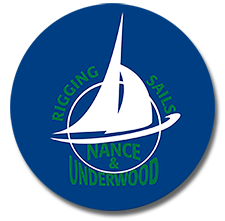 |
Quality Rigging Since 1988
Lloyds Accredited
First in Service and Installs
|

954-764-6001 · 800-328-9782

|
|
|
|
|
ATN Sailing Gear
 he ATN Spinnaker Sleeve lets you raise and douse a spinnaker with ease. The ATN Tacker allows you to use your conventional (symmetric) spinnaker like an asymmetric spinnaker from beam reaching to broad reaching without the need of the spinnaker pole. A new addition to the ATN product line is Multihull Nets. See more below. he ATN Spinnaker Sleeve lets you raise and douse a spinnaker with ease. The ATN Tacker allows you to use your conventional (symmetric) spinnaker like an asymmetric spinnaker from beam reaching to broad reaching without the need of the spinnaker pole. A new addition to the ATN product line is Multihull Nets. See more below.
| The SPINNAKER SLEEVE |
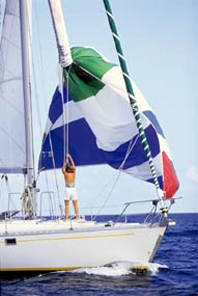
|
"There is no question, the difference is worth it" -- Practical Sailor Magazine
"Ten years ago we first tried an ATN spinnaker sock on our 67-foot Sundeer. The result was extraordinary. The ATN system worked well enough for two of us to use our spinnaker more often than not on downwind passages. Today my wife Linda and I still use the ATN sock on our 78-foot Beowulf, and recommend it to all our clients. There simply is not a better way to handle a spinnaker."
-- Steve Dashew / Sundeer Yachts
|
"Anybody can get a sail up--
It takes a sailor to get it down"
|
That statement is particularly true regarding the spinnaker. The problem is not to hoist the sail but to get it back on the boat. That's when the spinnaker sleeve makes the average sailboat owner a great sailor. Without any help, he makes that very powerful and expensive sail disappear with a minimum of fuss and trauma. And the sail is ready to be hoisted again immediately, no more packing!
While it would seem that a spinnaker sleeve is a simple sailing tool, and that any one with a sewing machine could design and fabricate one, when dealing with large sails, the problems increase rapidly in complexity and cost. It is very plausible to get hurt or to inflict great injury to others, and to one's wallet, if the system used is inadequate. But there is no need to rub it in, especially at sea: it has to work and be reliable.
|
| Problems Solved by the ATN Spinnaker Sleeve |
- The main problem to solve was the mixing of the control lines and the sail.
A separate channel (which contains the control line) is sewn alongside the main sleeve which contains the spinnaker. The spinnaker and the control line are completely separated . The separate channel (side sleeve) is made of a different colored cloth than the main sleeve which shows the eventual twists of the sleeve prior of hoisting it. There will often be some twists in the sleeved spinnaker as it comes out of the bag, especially after long periods of storing and moving it around the sail locker. Needless to say, those twists are to be removed before hoisting the sleeve.
- Another problem to address was the opening, the mouth of the sleeve.
 It had to be rigid to remain open when pulled against the sail, slippery to enable it to slide over the sail without chafing it, light (weight aloft should always be avoided) and sturdy enough not to break in the bag when stepped on or stored. Fiber glass was, from the beginning, the material of choice by its versatility and ease of manufacturing. While the round shape seems obvious, the oval shape is more spinnaker friendly for it doesn't have the tendency to rotate around the sail as it is guided by the spinnaker leeches and it is easier to slide through the hatch when storing below deck. We make them out of Kevlar and glass which, while expensive, offers a good combination of strength and lightness. It had to be rigid to remain open when pulled against the sail, slippery to enable it to slide over the sail without chafing it, light (weight aloft should always be avoided) and sturdy enough not to break in the bag when stepped on or stored. Fiber glass was, from the beginning, the material of choice by its versatility and ease of manufacturing. While the round shape seems obvious, the oval shape is more spinnaker friendly for it doesn't have the tendency to rotate around the sail as it is guided by the spinnaker leeches and it is easier to slide through the hatch when storing below deck. We make them out of Kevlar and glass which, while expensive, offers a good combination of strength and lightness.
The control line is a closed loop, made of 2 different lines. One side is to hoist the sleeve. It must not kink and it should be small enough to travel in the side sleeve and through the top turning block. The other side must be much heavier as it is handled by the operator to douse the sail. It also must not kink as well as be long enough to be lead through a snatch-block, as Steve Dashew suggests in his very thorough "Offshore Cruising Encyclopedia", in the fore deck and then to a cleat or a winch on bigger boats.
- The cloth problem came from the fact that spinnaker or bag cloth doesn't breathe and might bleed.
The cloth that is milled especially for ATN is a "tricot", a mesh like material which is light, strong, and doesn't retain water. The sail can dry when in the sleeve and it will not cling to the sail when hoisting the sleeve, even after long period of wet storing.
- Finally, the spinnaker is fastened inside the spinnaker sleeve with a swivel shackle to allow gibing.
The hoisted spinnaker sleeve must always remain in the same position at the mast head, on top of the flying spinnaker, while allowing the spinnaker to rotate under itself. This also gives more flexibility when loading the sail.
|
| Features of the ATN Spinnaker Sleeve |
- Single hand any spinnaker, reacher, gennaker, MPS, screecher or mizzenstaysail up to 15,000 sq. ft. (Mega sloop Frers/Huisman 156' "Hyperion")
- High-tech, ultra-light Kevlar Hoop matches shape of the spinnaker and will not warp under load
- Single control line led through separate sleeve eliminates fouling
- Contrasting visual reference stripe
- Wire pennant with swivel at head of spinnaker prevents sleeve from affecting sail shape by allowing the sleeve to accumulate on the pennant
- Mesh construction allows sail to breathe, so that sails dry quicker, even while stored
|
|
|
|
| Accessories |
| ATN SnapRatchet
ATN now offers a SnapRatchet block to facilitate the dousing of the ATN spinnaker sleeve. The advantages of using the ATN SnapRatchet are threefold:
- ensures the operator that the control lines never escape his or her hands
- gives a mechanical advantage when lowering the ATN spinnaker sleeve
- allows the operator to sit down while lowering the ATN spinnaker sleeve
|
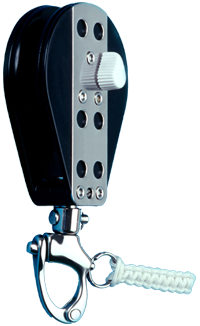 |
| Item |
|
3/8" SnapRatchet SR38,
for boats up to 35' |
|
1/2" SnapRatchet SR12,
for boats over 35' |
|
|
|
|
| the TACKER |
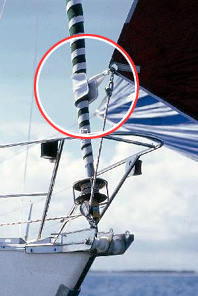
|
"We think the TACKER is a terrific way for casual sailors to get more use out of their spinnakers" ... "The inexpensive TACKER allows you to fly a conventional spinnaker without a pole"
-- Practical Sailor
The ATN difference is worth it.
The patented "Tacker" has been developed to control the tack of the cruising spinnaker (asymmetric) by fastening it over the furled headsail and it allows you to use your conventional (symmetric) spinnaker like an asymmetric spinnaker from beam reaching to broad reaching without the need of the spinnaker pole.
|
| About the TACKER |
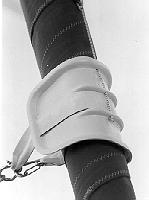 Here is the sequence: Attach the halyard to the spinnaker's head, the sheet to the spinnaker's clew, the downhaul to the spinnaker's tack where the TACKER has already been shackled, pass the TACKER around the furled headsail, clip the snap shackle onto the spinnaler's tack and hoist away. Trim the sheet and the downhaul and you are sailing. The downhaul, in most cases, can be replaced by a rope pennant always on the spinnaker's tack, making the operation even easier. Here is the sequence: Attach the halyard to the spinnaker's head, the sheet to the spinnaker's clew, the downhaul to the spinnaker's tack where the TACKER has already been shackled, pass the TACKER around the furled headsail, clip the snap shackle onto the spinnaler's tack and hoist away. Trim the sheet and the downhaul and you are sailing. The downhaul, in most cases, can be replaced by a rope pennant always on the spinnaker's tack, making the operation even easier.
Of course you can fly a spinnaker without a pole and without the TACKER, but bear in mind that a conventional spinnaker is designed to fly a couple of feet above the lifelines. Its foot (between the clew and the tack) should always be horizontal. Securing the spinnaker tack to the deck is not the best way to set the sail. It is too low and the spinnaker will chafe on the bow pulpit and lifelines. If you add a pennant or a downhaul, the spinnaker falls off to leeward and the pennant chafes on the pulpit and the sail looses its shape.
That's when the TACKER saves the day. It holds the tack, and the luff, of the spinnaker close to the centerline of the boat and it can be adjusted up and down with the downhaul for a perfect trim.
The NEW Tacker is now fitted with a snapshakle, which allows the operator to "blow the tack" of the spinnaker, making it even easier to control the sail.
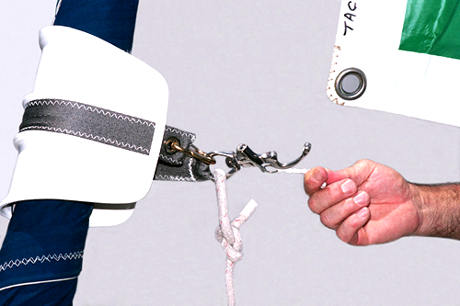
|
| ATN Multihull Nets |
New from ATN are multihull nets for the "trampolines" commonly found on all multihull boats. ATN Multihull Nets are of two styles, cruising and racing. Contact Us for a quote for your Multihull Net application.
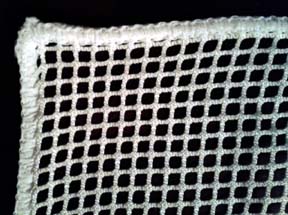 |
|
|
|
|
|
Nance & Underwood Rigging and Sails is your source for all of your rigging, sails, sail handling equipment and services world wide. We can ship rigging, sails, and sail handling equipment anywhere. No matter where you are, Nance & Underwood will always be here to assist you. We can arrange the repair of your rigging hardware and/or sails here in our facility. Contact Us today for more information.
|
|
|
. |
 Bureau Veritas Cert.
Bureau Veritas Cert.  Lloyd's Service Provider
Lloyd's Service Provider U.S. Federal Contractor Registration
U.S. Federal Contractor Registration  Marine Industries Assoc.
Marine Industries Assoc.